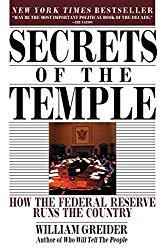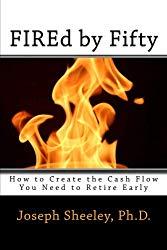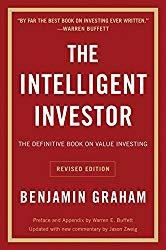Perhaps you noticed that there was a slight bobble in the stock market this week. OK, it was a gut-wrenching, stomach dropping, panic creating, confidence-killing 6-10% drop in many of the market averages. A contributing factor to this decline was the decision by the Federal Reserve to continue to hike interest rates as they have been doing for about three years now. The Fed Funds Rate, which is the interest rate banks charge each other for overnight loans, has gone from 0.25 percent, a record low, to a more normal 2.25%. Additional rate increases are expected over the next two years, which is what has the stock market worried.
(Note, this site contains affiliate links. When you click on an affiliate link and buy something, The Small Investor will get a small commission for the referral. You are charged nothing extra for the purchase. This helps keep The Small Investor going and free. I don’t recommend any products I do not fully support. If you would like to help but don’t see anything you need, feel free to visit Amazon through this link
So, why do you care what banks charge each other for short-term loans? What is the Federal Reserve? And why are they killing the great gains I’ve had in the stock market this year? Great questions. If you’re a financial die-hard like me, you’ll love the book, Secrets of the Temple: How the Federal Reserve Runs the Country

Why Stocks Go Up
The first thing to know before you can understand the effect of interest rates is why stocks go up in the first place. When you buy shares of a stock, you are acquiring an ownership position in a company. This means, among other things, that you are entitled to a share of the money generated by the company. When a company is young and growing, most of the money generated will be pumped back into the company. As it gets older and has a steady business, however, it will start to pay out some of its profits in the form of dividends. These are typically paid four times a year with perhaps a special bonus dividend at the end of the year. (To learn more about dividends and how you can use them to generate passive income, check out The Little Book of Big Dividends: A Safe Formula for Guaranteed Returns
The rate-of-return that you’ll get from dividends, called the yield, will generally be less for stocks than it will be from the interest payments you’ll get from bonds. For example, you might be able to get a 5% interest rate from a high-quality bond, but only a 1% yield from a stock. Over time, however, stock dividends can grow where bond payments are typically fixed. As the company makes more and more money, it may raise its dividend as well. For example, if a company pays out 1/4 of its profits as dividends, if it makes $10 per share, it will be paying out $2.50 per year. If its profits grow to the point where it is making $100 per share and they continue to pay out 25% as dividends, the dividend will have grown to $25 per share. A bond that starts out paying $100 per year, on the other hand, will always pay $100 per year until it eventually matures and ceases to be. So, in the short term, you’ll get more cash from a bond, but if you hold it for a long time, you’ll eventually get a bigger payment per year from a stock.
Now, people tend to expect a given yield from a stock based on what risk they are taking and what other companies are paying. If a stock is paying less than this basic yield, investors may sell and go to another stock that is paying more. Likewise, if a stock is paying more than this basic yield, people may shift to this stock for the higher yield and in doing so bid up the price. Because the amount a stock pays out per share tends to be fixed for a few quarters or for a few years, the yield you receive is based on the price you pay for the stock. If a stock is paying out $1 per share per year and you pay $10 per share, you’ll be receiving a yield of 10%. If you pay $20 per share for this same stock, you’ll be receiving a yield of 5%. This means that if you pay more for a given stock, your yield will be less than it will be for someone who pays less. When you buy in, you effectively lock in your yield.
If you enjoy The Small Investor and want to support the cause, or you just want to learn how to become financially independent, please consider picking up a copy of my new book, FIREd by Fifty: How to Create the Cash Flow You Need to Retire Early

FIREd by Fifty: How to Create the Cash Flow You Need to Retire Early
As companies become more profitable and earn more per share, they tend to raise their dividends. This means that the yield you would receive if the price per share remained fixed would grow over time. A stock that paid you 1% when you bought in might be paying you 10% after five or ten years if the company were growing rapidly. The price of the stock does not remain fixed, however. Because the payout is going up, people are willing to pay more for the shares, causing the price per share to rise. If a stock were selling at $10 per share and had a dividend of $1 or 10% per share and other stocks were only paying 5% yields, people might be interested in buying the shares and be willing to pay $20 per share since that would still mean a 5% dividend. If people were interested in getting a cash payment and other companies were only paying 2.5%, they might even bid the shares up until they reached $40 per share since they would then be receiving that same 2.5% yield. If they bid the shares up past that point, they would be receiving a lower yield than the average they could get elsewhere, so that probably wouldn’t happen unless they thought the dividend would be increased again soon.
So, as companies make more money and are able to raise their dividends, people bid up their prices since they, in turn, will receive more money per share. For example, if a company is growing earnings at 10% per year, and therefore increasing dividends at 10% per year, you can expect the average share price to increase by about 10% per year. You could also say that the fair value of the stock is increasing by 10% per year. At times that stock’s price may be above this fair value, other times it will be below, but on average, the price will go up by about 10% per year. This means that it would double in price about every 7 years. Investing based on fair value is called Value Investing. To learn more about value investing, please read
The Intelligent Investor: The Definitive Book on Value Investing. A Book of Practical Counsel

Higher Interest Rates Hurt Profits
Remember now that higher dividends are the result of higher profits. If a company is able to grow and make more money, profits will go up and therefore so will the dividend. Know also that stock prices are not based upon how well the company is doing right now, but how people expect the company to be doing in the future. Prices go up when people expect profits to rise and are therefore willing to pay more per share. Prices go down when people expect profits and dividends to fall and therefore are unwilling to buy unless the share price is low enough. For example, if a company is paying a dividend of $10 per share right now and trading at $100 per share, but people expect the company to cut the dividend down to $5 per share in the future, they may be only willing to pay $50 per share so that the yield will remain at 10%. Likewise, if they think that a company will double their profits next year and be able to double their dividend, they may go ahead and pay twice for what the stock is selling now since they expect the higher future yield.
When the Fed raises interest rates such as the Fed Funds Rate, most consumer interest rates rise as well. The rates for home loans, car loans, and business loans go up. This means that companies will need to pay higher interest on business loans. This both means that they have less money available to put into their business since they’ll be paying more out in interest payments and that they are less likely to take out loans in the first place. If they are not taking out loans to buy new equipment, build more locations, or do more research, it means their profits will not be growing, so their dividends will not be growing as fast. This means that their share price will not go up as fast as it was when rates were lower. If interest rates are too high, businesses may stop expanding entirely and may even contract as they lay off workers and close down capacity to save money, causing share prices to fall. Higher consumer rates also mean that people will not be taking out loans to build houses, go on vacations, and send their children to college. This means there is less money being spent and lower profits for businesses.

Want all the details on using Investing to grow financially Independent? Try The SmallIvy Book of Investing.
Higher Interest Rates Mean Competition for Investments
Another reason that stocks go down when interest rates go up is that other things that pay interest, like bonds and REITs, start paying higher interest rates. Because people can now get a higher return in bonds, they demand an even higher return from stocks since a bond payout is far more certain than the return someone will get from a stock investment since a lot of the return is in the form of capital gains. (Capital gains are the profits you make when you sell a stock at a higher price than you paid for it. While the price of a stock goes up when the dividend goes up, most people actually invest to make money from increases in the share price.)
Remember from the discussion above that the fair value price of a stock tends to go up along with profits and dividends. You can think of this as the average speed of a wild river, where the speed of any given part of the river will vary wildly, but if you place something in the river you can do a fairly good job of predicting how far downstream it will be in a few hours even if you can’t predict where it will be in the next minute because of all the eddies and turbulence. With a stock, you can do a fairly good job predicting its average price in a few years based on its earnings growth rate and fair value, but predicting what the price will be from day-to-day or month-to-month is very difficult. So you can see that earnings are growing by 10% per year and surmise that if they continue to do so the average stock price should double about every 7 years. Predicting where the stock price will be in one year or three years, however, is very difficult. It could shoot up quickly and then pause for a while, grow steadily over the next several years, or it could just sit at current prices for a year or more and then surge up.
So, the earnings growth rate can be used to predict the stock price in the future, which means you can make some predictions of the total return you’ll get. The actual return you’ll get, however, is somewhat uncertain. (For some stocks, those that have unpredictable earnings, total return is very uncertain.) Stocks are therefore priced based on both the possible rate of return and the probability that they will actually provide that rate of return. If you think that there is a 50-50 chance that a stock will go to $50 in ten years and it is trading at $25 per share right now, you might decide that it is not worth the risk since that would only be a 7% annualized return for a fairly substantial risk. If it were trading at $10 per share, however, you would make 500% in ten years, or a return of around 30% per year if it performed as expected. For that big a return, you might take the risk.


Buy your Halloween Costumes and Accessories
If interest rates go up and bonds start paying a higher interest rate, it means that the possible return on stocks needs to increase to make people decide to buy stocks instead of bonds. For example, if you have a possible return of 7% annualized from a stock, but you could also buy a bond where you were almost certain to receive 6% return per year, you might decide it was not worth the risk to buy the stock for the small additional return you could receive. If the stock dropped in price to the point where the annualized return increased to 15% for the stock, however, you might then decide that it was worth the added risk. People trying to sell their shares would, therefore, need to lower the price they were willing to receive or they would not be able to find a buyer.
So, in summary, stocks go down in price when interest rates increase, both because higher interest rates may affect profits and because higher rates increase the returns for competing assets, meaning that people will only buy stocks if they can pay a low enough price to make the possible returns worth the risk.
More details on this strategy can be found in The SmallIvy Book of Investing.
Have a burning investing question you’d like answered? Please send to [email protected] or leave in a comment.
Follow on Twitter to get news about new articles. @SmallIvy_SI
Disclaimer: This blog is not meant to give financial planning or tax advice. It gives general information on investment strategy, picking stocks, and generally managing money to build wealth. It is not a solicitation to buy or sell stocks or any security. Financial planning advice should be sought from a certified financial planner, which the author is not. Tax advice should be sought from a CPA. All investments involve risk and the reader as urged to consider risks carefully and seek the advice of experts if needed before investing.
